|
The
Sporting Breeds
page 1
page 2 |
|
Lagotto
Romagnolo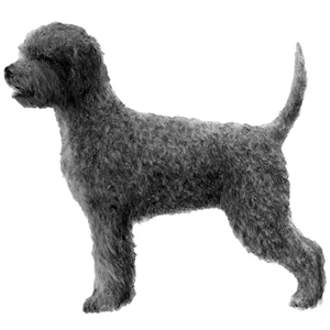
The Lagatto
Romagnool, Italy's adorable 'truffle dog', sports a curly coat and
lavish facial furnishings. Despite their plush-toy lood, Lagotti are
durable workers of excellent nose who root out truffles, a dainty and
pricey delicacy. Italians have a word for it:'carino'. In English, we
say 'cute.' In ay language, this breed is totally endearing. The Lagotto
Romagnolo (plural: Lagotti Romagnoli) is known for wooly curls that
cover the body head to tail, crowned by a lavish beard, eyebrows and
whiskers. Lagotti stand under 20 inches and weigh no more than 35
pounds. But don't be fooled by their teddy-bear looks, these are rugged
workers of true strength and endurance. the breed's trademark curls feel
and behave more like human hair than fur.
A Look
Back
Lagotti go back to at least Renaissance Italy, where they were bred as
waterfowl retrievers working the marshlands of Ravenna. “Lago” is
Italian for “lake.” |
|
Nederlandse Kooikerhondje
The
Nederlandse Kooikerhondje is lively, agile, self-confident, good-natured
and alert. The breed is faithful, easy-going and friendly in the home.
Outdoors he is a true sporting dog being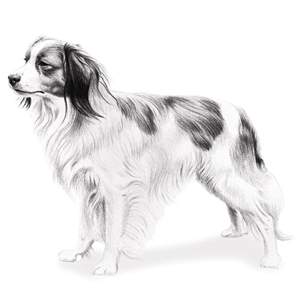 keen, swift, tough, attentive and energetic. With sufficient
perseverance and stamina, he enjoys working and does so with a cheerful
character.
keen, swift, tough, attentive and energetic. With sufficient
perseverance and stamina, he enjoys working and does so with a cheerful
character.
The
Kooikerhondje (Koi-ker-hond-yuh)'the 'little white and orange dog with a
big heart' is a sporty, eye-catching fellow with a silky all-weather
coat of white with red patches. They are instantly recognizable thanks
to their large, black-tipped ears and the richly feathered tail they wag
proudly. The breed has the sturdy bone structure expected of a serious
hunter, but the overall picture is that of a harmoniously built dog of
smooth, flowing contours and springy gait. The Nederlandse Kooikerhondje
Club of the United States has served as the AKC Parent Club to represent
the Kooikerhondje since April 2014.
A Look
Back
The Nederlandse Kooikerhondje is a very old breed, appearing in
paintings by the Dutch masters back into the late Middle Ages. The
breed was used in the “Eendenkooi” the manmade duck-trapping pond
systems, beginning prior to the invention of gunpowder. These “Duck
Decoys” – as they were called in English – are not to be confused with
carved wooden faux ducks, but were instead hand-dug ponds ranging from 3
to 10 acres in size. The breed was also associated with the founder of
the Dutch Monarchy, Prince William of Oranje, whose “Kooiker” Kuntz was
credited with saving the Prince’s life when assassins sought to kill
him. |
|
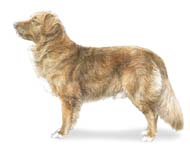 Nova
Scotia Duck Tolling Retriever Nova
Scotia Duck Tolling Retriever
Medium sized, powerful and compact, the
Nova Scotia Duck Tolling Retriever is the smallest of the retrievers. He
developed in the early 19th century to toll, lure, and retrieve waterfowl.
The playful action of the Toller retrieving a stick or ball along the
shoreline arouses the curiosity of the ducks offshore. This lures them
within gunshot range, and then the dog is sent out to retrieve the dead or
wounded birds. Their water-repellant double coat is any shade of red,
often with white markings.
A Look Back
There is no authentic record of the development of the Toller, but present
day thinking is that the basic stock was the red decoy dog, probably
brought to Nova Scotia with the early settlers from Europe. Crosses with
other breeds, possibly spaniel and setter-type dogs, retriever-type dogs,
and farm collie, produced today’s Toller. Originally known as the Little
River Duck Dog after the district of Yarmouth County, or as a Yarmouth
Toller, the Toller has now bred true for generations.
Right Breed for You?
Highly intelligent, alert and outgoing, the Toller is normally ready for
action, desiring a job to do or some kind of activity. He is affectionate
and loving with family members and is good with children, showing
patience. A natural-looking breed, the Toller does not require much coat
maintenance beyond occasional brushing and baths. |
|
 Pointer Pointer
A hard-driving hunting dog possessing
stamina, courage, and the desire to go, the Pointer is bred primarily for
sport afield and definitely looks the part. He gives the impression of
power and grace, with a noble carriage, an intelligent expression and a
muscular body. His short coat can be liver, lemon, black, and orange;
either in combination with white or solid-colored.
A Look Back
Pointers first appeared in England around 1650 and were the first breed
used to stand game. Before wing-shooting with guns became popular,
Pointers were often used to locate and point hares in conjunction with
Greyhound coursing. The Pointer's lineage is foggy, but there is no
question that it includes Foxhound, Greyhound, and Bloodhound crossed with
some sort of "setting spaniel," which played an important part
in the creation of all modern bird dogs.
Right Breed for You?
The Pointer's even temperament and alert good sense make him a congenial
companion both in the field and in the home, but he requires both physical
and mental exercise. He should be dignified, but should never show
timidity toward man or dog. The breed’s short coat is easy to care with
minimal effort. |
|
 Spinone
Italiano Spinone
Italiano
An excellent retriever by nature and an
experienced hunter on any terrain, the Spinone is robust, sociable and
docile. His wiry, dense coat and thick skin enable him to negotiate
underbrush and endure cold water that would severely punish any dog not so
naturally armored. The coat can be solid white; white and orange; orange
roan with or without orange markings; white with brown markings, brown
roan with or without brown markings.
A Look Back
The Spinone Italiano, or Italian Pointer, is Italy's all-purpose hunting
dog. The dog is a Pointer of the old school, that is, a rather slow-footed
dog similar to those used before the era of wing shooting. It is estimated
to be a cross of coarse-haired Italian Setters, bred with those left by
Greek traders and others from the Adriatic coast, in addition to crosses
with the White Mastiff and perhaps French Griffons.
Right Breed for You?
An active, energetic breed, the Spinone loves to romp in the field, but is
happy as long as it’s with its family. As a naturally cautious dog,
owners should socialize the breed and begin training early. The Spinone is
the ultimate wash and wear breed and should remain in a natural state,
with just occasional brushing and hand-stripping. Owners beware, however
– after a drink, their wet and messy beard may leave trail of water
wherever they go! |
|
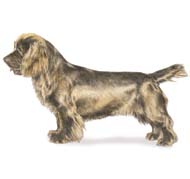 Sussex
Spaniel Sussex
Spaniel
Although the Sussex Spaniel originated
centuries ago, the breed’s appearance has remained virtually unchanged
still today. The Sussex possesses a rich golden liver coat unique to the
breed, and has a long, low and somewhat massive body. Although not as fast
as other Spaniel breeds, the Sussex has a great nose and is well suited
for working through dense underbrush on the hunt.
A Look Back
While the Sussex Spaniel was one of the original nine breeds recognized by
the AKC in 1884, it has actually existed as a breed for much longer. It
originated in the 18th century in the county of Sussex, England, where it
was used as a field dog. At that time, the custom of hunting on foot made
the Sussex a popular hunting companion and very useful in flushing and
retrieving upland game.
Right Breed for
You?
Despite its somber and serious expression, the Sussex is friendly, with a
cheerful and tractable disposition. They enjoy walks with their families
and are good with children and other dogs. The Sussex requires weekly
brushing, with special attention paid to anything that might have gotten
caught in their long, thick ear hair. Owners should also be prepared for a
large quantity of drool. |
|
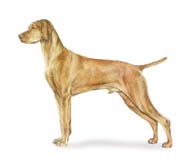 Vizsla Vizsla
Originally from Hungary, the Vizsla is a
medium-sized, short-coated hunting dog that is essentially Pointer in
type, although he combines characteristics of both pointer and retriever.
An attractive golden rust in color, this "dual" dog is popular
in both the field and the show ring due to his power and drive while
hunting and his trainability in the home.
A Look Back
The Vizsla’s ancestors were hunters and companions for the Magyar
hordes, a tribe that settled in what is now known as Hungary. A favorite
of early barons, Vizslas are depicted in etchings as far back as the 10th
century.
The agricultural terrain of Hungary
created a dog of superior nose and high-class hunting ability well-suited
to Hungarian climate and a variety of game, including upland game, rabbits
and waterfowl. Nearly extinct by the end of the World Wars, the Vizsla
gradually regained popularity and began to be imported into the United
States in the 1950s.
Right Breed for You?
The Vizsla thrives as part of an active family that provides daily
exercise. He is lively and affectionate to his people, and possesses an
above-average ability to take training. Although he sheds, his short coat
requires low daily maintenance. |
|
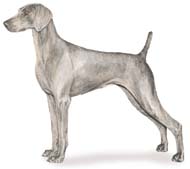 Weimaraner Weimaraner
Often referred to as the "grey
ghost" because of the distinctive color of its short, sleek coat, the
Weimaraner is a graceful dog with aristocratic features. Bred for speed,
good scenting ability, courage and intelligence, he remains an excellent
game hunter and active participant in other dog sports.
A Look Back
Originally known as the Weimer Pointer (derived from the court that
sponsored the breed), the Weimaraner is a product of selective German
breeding and comes from the same general stock as other German hunting
breeds. It is believed to be a descendant of the Bloodhound and was
originally used to hunt wolves, deer and bear. Over the years because of
the rarity of bigger game in his surroundings, the Weimaraner adapted to
become a bird dog and personal hunting companion.
Right Breed for You?
Lauded for his ability to work with great speed, fearlessness and
endurance when on the hunt, the Weimaraner is also known for being an
easily trainable, friendly and obedient member of the family. This is a
breed that loves children and enjoys being part of his family’s
"pack." Grooming maintenance is low due to his short coat. |
|
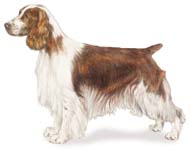 Welsh
Springer Spaniel Welsh
Springer Spaniel
A compact dog built for hard work, the
Welsh Springer Spaniel is a distinct breed, not a variety of the English
Springer Spaniel. With his excellent nose and slightly webbed feet, the
breed is a versatile hunter, water dog and retriever. Their trademark coat
is a striking red and white in color.
A Look Back
During the Renaissance, the "Land Spaniel," a Welsh
Springer-type dog with red and white markings, was used for retrieving,
and tapestries of the time depict a dog very similar to the Welsh.
Originally, he was bred to spring game toward a net or into the air prior
to the invention and common use of the gun. Although the breed was
fashionable with the nobility in the 1700s, the English Springer Spaniel
soon replaced it in popularity. A small group of breeders kept the breed
from becoming extinct.
Right Breed for You?
Active, loyal and possessing an even disposition, the Welsh Springer
Spaniel is an excellent companion for families and hunters alike. The
breed is a "velcro" dog and prefers to be with its people. Welsh
Springers possess a stubborn streak, but respond well to training if it
starts early. This athletic dog needs daily exercise and at least weekly
brushing to maintain its coat. |
|
Wirehaired
Pointing Griffon
Medium sized and bred to cover all
terrain encountered by the walking hunter, the Wirehaired Pointing Griffon
has been called the "4-wheel drive of hunting dogs" as he will
enter briars or underbrush without hesitation. Griffs excel equally as
pointers in the field and as retrievers in the water. Their coarse double
coat protects them in rough cover and gives them an unkempt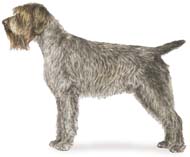 appearance. It
can be a variety of colors, most often steel gray with brown markings. appearance. It
can be a variety of colors, most often steel gray with brown markings.
A Look Back
Griffon-like dogs have existed throughout history, but exact origins are
uncertain. The modern history of the breed, however, has been well
documented. Dutchman Eduard Korthals was an avid hunter and desired a dog
that could hunt over a variety of terrain, so he developed a breeding
program to create a versatile new sporting breed. In less than two
decades, Korthals had fixed the new breed he called the Wirehaired
Pointing Griffon, wrote the standard and formed a Griffon club.
Right Breed for You?
The Griffon’s easy trainability, devotion to family, and friendly
temperament endear him to all. He thrives on human companionship and
prefers to be house dog. The breed’s wiry coat will not develop fully
until the dog is about 2-3 years old and is maintained with regular
brushing and stripping. This sporting dog needs plenty of exercise to keep
it physically and mentally fit. |
|
Wirehaired Vizsla
The Wirehaired Vizsla is an exuberant hunter on land or lake, whose
dense, wiry coat distinguishes him from his close cousin, the Vizsla.
Calm and gentle around the house, these upbeat Hungarians like running,
swimming, and upbeat play. WVs are close relatives of Vizslas but a
distinctly separate breed. The key distinguishing feature is coat type.
Unlike the sleek Vizsla, WVs have a dense wiry coat, with a shaggy beard
and eyebrows setting off a bright, lively expression. Both Vizsla breeds
are classified as medium-sized, but an ideal WV will stand a shade
taller and be a bit heavier than his smooth-coat cousin. The two breeds
share the same striking red coloring (golden-rust), with a nose and eyes
that smartly complement the coat.
A Look Back
The origins of dogs developed in the 20th century are much better
documented than older breeds, so we know in detail of how Wirehaired
Vizslas were created in the 1930s. But here’s the short version:
Hungarian hunters and falconers wanted a dog with the same drive and
versatility of their beloved Vizslas, but with a sturdier frame and a
denser coat, the better to work on punishing terrain and in the cold
weather of northern Hungary. They achieved this by judicious crosses of
Vizslas and German
Wirehaired Pointers. |
page 1
page 2
(breed information from the AKC website)

|